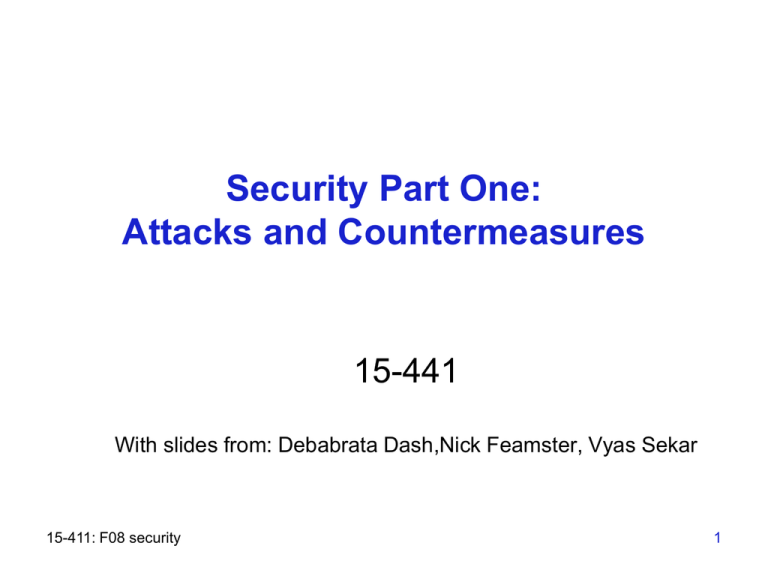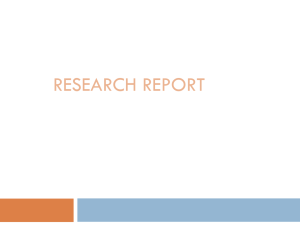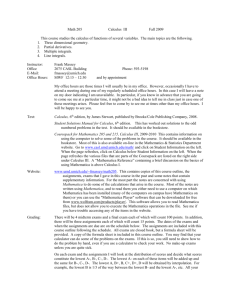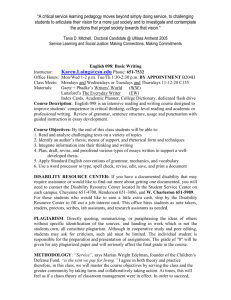Security Part Two: Attacks, Firewalls, DoS
advertisement

Security Part One: Attacks and Countermeasures 15-441 With slides from: Debabrata Dash,Nick Feamster, Vyas Sekar 15-411: F08 security 1 Flashback .. Internet design goals 1. 2. 3. 4. 5. 6. 7. 8. Interconnection Failure resilience Multiple types of service Variety of networks Management of resources Cost-effective Low entry-cost Accountability for resources Where is security? 15-411: F08 security 2 Why did they leave it out? • Designed for connectivity • Network designed with implicit trust No “bad” guys • Can’t security be provided at the edge? Encryption, Authentication etc End-to-end arguments in system design 15-411: F08 security 3 Security Vulnerabilities • At every layer in the protocol stack! • Network-layer attacks IP-level vulnerabilities Routing attacks • Transport-layer attacks TCP vulnerabilities • Application-layer attacks 15-411: F08 security 4 IP-level vulnerabilities • IP addresses are provided by the source Spoofing attacks • Using IP address for authentication e.g., login with .rhosts • Some “features” that have been exploited Fragmentation Broadcast for traffic amplification 15-411: F08 security 5 Security Flaws in IP • The IP addresses are filled in by the originating host Address spoofing • Using source address for authentication r-utilities (rlogin, rsh, rhosts etc..) 2.1.1.1 C •Can A claim it is B to the server S? •ARP Spoofing Internet 1.1.1.3 S 1.1.1.1 A 15-411: F08 security 1.1.1.2 B •Can C claim it is B to the server S? •Source Routing 6 Smurf Attack Internet Attacking System Broadcast Enabled Network Victim System 15-411: F08 security 7 ICMP Attacks • No authentication • ICMP redirect message Can cause the host to switch gateways Benefit of doing this? Man in the middle attack, sniffing • ICMP destination unreachable Can cause the host to drop connection • ICMP echo request/reply • Many more… http://www.sans.org/rr/whitepapers/threats/477.php 15-411: F08 security 8 Routing attacks • Divert traffic to malicious nodes Black-hole Eavesdropping • How to implement routing attacks? Distance-Vector: Link-state: • BGP vulnerabilities 15-411: F08 security 9 Routing attacks • Divert traffic to malicious nodes Black-hole Eavesdropping • How to implement routing attacks? Distance-Vector: Announce low-cost routes Link-state: Dropping links from topology • BGP vulnerabilities Prefix-hijacking Path alteration 15-411: F08 security 10 TCP-level attacks • SYN-Floods Implementations create state at servers before connection is fully established • Session hijack Pretend to be a trusted host Sequence number guessing • Session resets Close a legitimate connection 15-411: F08 security 11 Session Hijack Server Trusted (T) Malicious (M) 15-411: F08 security First send a legitimate SYN to server 12 Session Hijack Server Trusted (T) Malicious (M) 15-411: F08 security Using ISN_S1 from earlier connection guess ISN_S2! 13 TCP Layer Attacks • TCP SYN Flooding Exploit state allocated at server after initial SYN packet Send a SYN and don’t reply with ACK Server will wait for 511 seconds for ACK Finite queue size for incomplete connections (1024) Once the queue is full it doesn’t accept requests 15-411: F08 security 14 TCP Layer Attacks • TCP Session Poisoning Send RST packet Will tear down connection Do you have to guess the exact sequence number? Anywhere in window is fine For 64k window it takes 64k packets to reset About 15 seconds for a T1 15-411: F08 security 15 An Example Shimomura (S) Finger Showmount -e SYN Trusted (T) • Finger @S • Attack when no one is around • showmount –e • What other systems it trusts? • Send 20 SYN packets to S 15-411: F08 security Mitnick • Determine ISN behavior 16 An Example X Shimomura (S) Syn flood Trusted (T) • Finger @S • Attack when no one is around • showmount –e • What other systems it trusts? • Send 20 SYN packets to S • SYN flood T 15-411: F08 security Mitnick • Determine ISN behavior • T won’t respond to packets 17 An Example SYN|ACK Shimomura (S) SYN ACK X Trusted (T) • Finger @S • Attack when no one is around • showmount –e • What other systems it trusts? • Send 20 SYN packets to S Mitnick • Determine ISN behavior • SYN flood T • T won’t respond to packets • Send SYN to S spoofing as T • S assumes that it has a session with T • Send ACK to S with a guessed number 15-411: F08 security 18 An Example X Shimomura (S) ++ > rhosts Trusted (T) • Finger @S • Attack when no one is around • showmount –e • What other systems it trusts? • Send 20 SYN packets to S Mitnick • Determine ISN behavior • SYN flood T • T won’t respond to packets • Send SYN to S spoofing as T • S assumes that it has a session with T • Send ACK to S with a guessed number • Send “echo + + > ~/.rhosts” 15-411: F08 security • Give permission to anyone from anywhere 19 Where do the problems come from? • Protocol-level vulnerabilities Implicit trust assumptions in design • Implementation vulnerabilities Both on routers and end-hosts • Incomplete specifications Often left to the imagination of programmers 15-411: F08 security 20 Outline • Security Vulnerabilities • Denial of Service • Worms • Countermeasures: Firewalls/IDS 15-411: F08 security 21 Denial of Service • Make a service unusable/unavailable • Disrupt service by taking down hosts E.g., ping-of-death • Consume host-level resources E.g., SYN-floods • Consume network resources E.g., UDP/ICMP floods 15-411: F08 security 22 Simple DoS •Attacker usually spoofs source address to hide origin •Aside: Backscatter Analysis •When attack traffic results in replies from the victim •E.g. TCP SYN, ICMP ECHO Lots of traffic Attacker 15-411: F08 security Victim 23 Backscatter Analysis • Attacker sends spoofed TCP SYN packets to www.haplessvictim.com With spoofed addresses chosen at random • My network sees TCP SYN-ACKs from www.haplessvictim.com at rate R • What is the rate of the attack? Assuming addresses chosen are uniform (2^32/ Network Address space) * R 15-411: F08 security 24 Reflector Attack Attacker Agent Reflector Reflector Agent Reflector Victim Src = Victim Destination = Reflector Reflector Reflector Src = Reflector Destination = Victim Unsolicited traffic at victim from legitimate hosts 15-411: F08 security 25 Distributed DoS Attacker Handler Agent Handler Agent Agent Agent Agent Victim 15-411: F08 security 26 Distributed DoS • Handlers are usually high volume servers Easy to hide the attack packets • Agents are usually home users with DSL/Cable Already infected and the agent installed • Very difficult to track down the attacker Multiple levels of indirection! • Aside: How to distinguish DDos from flash crowd? 15-411: F08 security 27 Outline • Security, Vulnerabilities • Denial of Service • Worms • Countermeasures: Firewalls/IDS 15-411: F08 security 28 Worm Overview • Self-propagate through network • Typical Steps in worm propagation Probe host for vulnerable software Exploit the vulnerability (e.g., buffer overflow) Attacker gains privileges of the vulnerable program Launch copy on compromised host • Spread at exponential rate 10M hosts in < 5 minutes Hard to deal with manual intervention 15-411: F08 security 29 Scanning Techniques • Random • Local subnet • Routing Worm • Hitlist • Topological 15-411: F08 security 30 Random Scanning • 32-bit randomly generated IP address E.g., Slammer and Code Red I What about IPv6? • Hits black-holed IP space frequently Only 28.6% of IP space is allocated Detect worms by monitoring unused addresses Honeypots/Honeynet 15-411: F08 security 31 Subnet Scanning • Generate last 1, 2, or 3 bytes of IP address randomly • Code Red II and Blaster • Some scans must be completely random to infect whole internet 15-411: F08 security 32 Routing Worm • BGP information can tell which IP address blocks are allocated • This information is publicly available http://www.routeviews.org/ http://www.ripe.net/ris/ 15-411: F08 security 33 Topological • Uses info on the infected host to find the next target Morris Worm used /etc/hosts , .rhosts Email address books P2P software usually store info about peers that each host connects to 15-411: F08 security 35 Some proposals for countermeasures • Better software safeguards Static analysis and array bounds checking (lint/e-fence) Safe versions of library calls gets(buf) -> fgets(buf, size, ...) sprintf(buf, ...) -> snprintf(buf, size, ...) • Host-diversity Avoid same exploit on multiple machines • Network-level: IP address space randomization • Host-level solutions E.g., Memory randomization, Stack guard • Rate-limiting: Contain the rate of spread • Content-based filtering: signatures in packet payloads 15-411: F08 security 36 Outline • Security, Vulnerabilities • Denial of Service • Worms • Countermeasures: Firewalls/IDS 15-411: F08 security 37 Countermeasure Overview • High level basic approaches Prevention Detection Resilience • Requirements Security: soundness / completeness (false positive / negative Overhead Usability 15-411: F08 security 38 Design questions .. • Why is it so easy to send unwanted traffic? Worm, DDoS, virus, spam, phishing etc • Where to place functionality for stopping unwanted traffic? Edge vs. Core Routers vs. Middleboxes • Redesign Internet architecture to detect and prevent unwanted traffic? 15-411: F08 security 39 Firewalls • Block/filter/modify traffic at network-level Limit access to the network Installed at perimeter of the network • Why network-level? Vulnerabilities on many hosts in network Users don’t keep systems up to date Lots of patches to keep track of Zero-day exploits 15-411: F08 security 40 Firewalls (contd…) • • • • Firewall inspects traffic through it Allows traffic specified in the policy Drops everything else Two Types Packet Filters, Proxies Internal Network Firewall Internet 15-411: F08 security 41 Packet Filters • Selectively passes packets from one network interface to another • Usually done within a router between external and internal network • What/How to filter? Packet Header Fields IP source and destination addresses Application port numbers ICMP message types/ Protocol options etc. Packet contents (payloads) 15-411: F08 security 42 Packet Filters: Possible Actions • Allow the packet to go through • Drop the packet (Notify Sender/Drop Silently) • Alter the packet (NAT?) • Log information about the packet 15-411: F08 security 43 Some examples • Block all packets from outside except for SMTP servers • Block all traffic to/from a list of domains • Ingress filtering Drop pkt from outside with addresses inside the network • Egress filtering Drop pkt from inside with addresses outside the network 15-411: F08 security 44 Typical Firewall Configuration • Internal hosts can access DMZ and Internet Internet • External hosts can access DMZ only, not Intranet • DMZ hosts can access Internet only • Advantages? • If a service gets compromised in DMZ it cannot affect internal hosts DMZ X X Intranet 15-411: F08 security 45 Firewall implementation • Stateless packet filtering firewall • Rule (Condition, Action) • Rules are processed in top-down order If a condition satisfied – action is taken 15-411: F08 security 46 Sample Firewall Rule Allow SSH from external hosts to internal hosts Two rules Inbound and outbound Client How to know a packet is for SSH? Server Inbound: src-port>1023, dst-port=22 SYN Outbound: src-port=22, dst-port>1023 Protocol=TCP SYN/ACK Ack Set? Problems? ACK Rule Dir Src Addr Src Port Dst Addr Dst Port Proto Ack Set? Action SSH-1 In Ext > 1023 Int 22 TCP Any Allow SSH-2 Out Int 22 Ext > 1023 TCP Yes Alow 15-411: F08 security 47 Default Firewall Rules • Egress Filtering Outbound traffic from external address Drop Benefits? • Ingress Filtering Inbound Traffic from internal address Drop Benefits? • Default Deny Why? Rule Dir Src Addr Src Port Dst Addr Dst Port Proto Ack Set? Action Egress Out Ext Any Ext Any Any Any Deny Ingress In Int Any Int Any Any Any Deny Default Any Any Any Any Any Any Any Deny 15-411: F08 security 48 Packet Filters • Advantages Transparent to application/user Simple packet filters can be efficient • Disadvantages Usually fail open Very hard to configure the rules May only have coarse-grained information? Does port 22 always mean SSH? Who is the user accessing the SSH? 15-411: F08 security 49 Alternatives • Stateful packet filters Keep the connection states Easier to specify rules Problems? State explosion State for UDP/ICMP? • Proxy Firewalls Two connections instead of one Either at transport level SOCKS proxy Or at application level HTTP proxy 15-411: F08 security 50 Intrusion Detection Systems • Firewalls allow traffic only to legitimate hosts and services • Traffic to the legitimate hosts/services can have attacks • Solution? Intrusion Detection Systems Monitor data and behavior Report when identify attacks 15-411: F08 security 52 Classes of IDS • What type of analysis? Signature-based Anomaly-based • Where is it operating? Network-based Host-based 15-411: F08 security 53 Signature-based IDS • Characteristics Uses known pattern matching to signify attack • Advantages? Widely available Fairly fast Easy to implement Easy to update • Disadvantages? Cannot detect attacks for which it has no signature 15-411: F08 security 54 Anomaly-based IDS • Characteristics Uses statistical model or machine learning engine to characterize normal usage behaviors Recognizes departures from normal as potential intrusions • Advantages? Can detect attempts to exploit new and unforeseen vulnerabilities Can recognize authorized usage that falls outside the normal pattern • Disadvantages? Generally slower, more resource intensive compared to signature-based IDS Greater complexity, difficult to configure Higher percentages of false alerts 15-411: F08 security 55 Network-based IDS • Characteristics NIDS examine raw packets in the network passively and triggers alerts • Advantages? Easy deployment Unobtrusive Difficult to evade if done at low level of network operation • Disadvantages? Fail Open Different hosts process packets differently NIDS needs to create traffic seen at the end host Need to have the complete network topology and complete host behavior 15-411: F08 security 56 Host-based IDS • Characteristics Runs on single host Can analyze audit-trails, logs, integrity of files and directories, etc. • Advantages More accurate than NIDS Less volume of traffic so less overhead • Disadvantages Deployment is expensive What happens when host get compromised? 15-411: F08 security 57 Summary • Security vulnerabilities are real! Protocol or implementation or bad specs Poor programming practices At all layers in protocol stack • DoS/DDoS Resource utilization attacks • Worm/Malware Exploit vulnerable services Exponential spread • Countermeasures: Firewall/IDS 15-411: F08 security 58








